#pre-programmed modules
Explore tagged Tumblr posts
Text

Buy ECM| PCM| ECU for your GMC - Clifford Auto Parts
Get top-quality GMC ECM, PCM, and ECU at Clifford Auto Parts. Our extensive selection includes genuine and high-performance engine control modules which are manufactured to optimize your vehicle's performance and reliability. Whether you're looking to replace a faulty ecm or upgrade for better efficiency, we offer reliable solutions for your needs. Shop with confidence and experience exceptional customer service for automotive requirements.
Visit us to know more: https://cliffordautoparts.com/product-category/gmc/
#ecm#pcm#engine control module repair#electronic control module#engine control module replacement#engine control module price#ecu repair service#automotive ecu repair#ecu for sale#pre programmed pcm#pcm powertrain control module#pcm car#pcm car part#automotive pcm
1 note
·
View note
Note
I have a very esoteric question for JF - I remember hearing you did the artwork or photography for the Miscellaneous T album cover. Were the letters cut out of foam? Using a heated wire cutter? The blocky flintstone-ey letters in an interesting hallway is still very cool. Thank you in advance for answering if you answer and thanks for always being great.

The cover of Miscellaneous T
First I designed the typeface on graph paper (which was actually a bigger project than the cover). This was the very end of the pre-computer era, and the word "font" went from being a shibboleth of design people to being common parlance. While computers were shaking up the world of graphic design the limitations were immediate. While the general public marveled at the 25 typefaces available, designers were sorely missing the other 2000.
(At this time I imported my very crude work into a computer-based font design program, and that file named Conant was even uploaded on to a free font site. I have no notion of how long it played out there or if it was ever used elsewhere, but I like to think there is a restaurant menu somewhere using Conant.)
The idea of my design was drawn from the hand lettering of artist Ben Shahn (although I did not have a lot of direct source material!) The big features of this kind of design is the squared-off letter shapes and the modulating upper and lower case forms. His letter changes from poster to poster but in general it looks like this...

I was also thinking about the woodcut letter shapes on the cover of Edward Albees famous paperback books (a book that was everywhere) I suspect the design was also Ben Shahn-influenced.
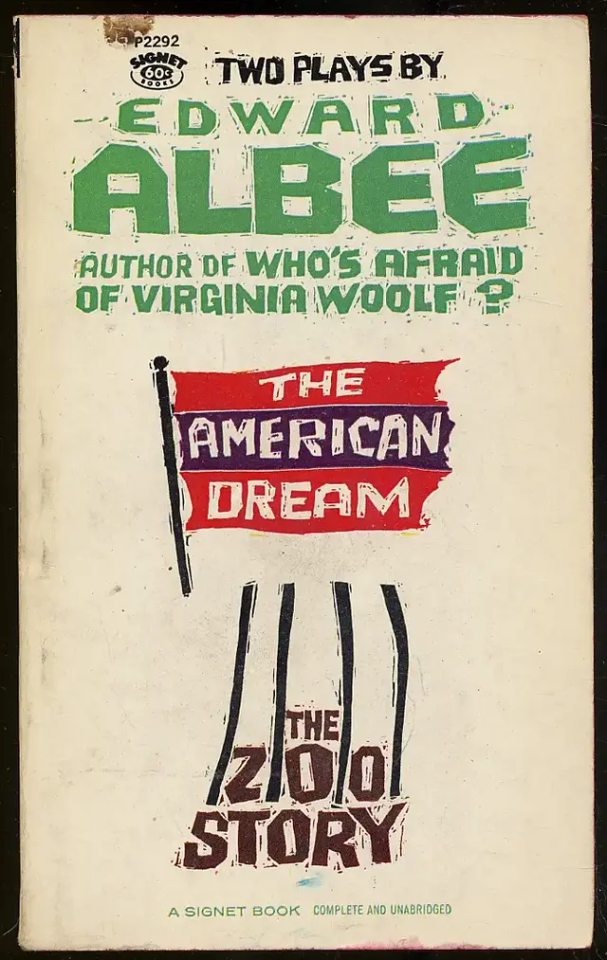
So regarding the cover of Misc. T-
The letters on the cover were made with an X-Acto knife, 1/4" foam-core, tape, Elmers glue, paper and acrylic paint. They are not solid at all. I made them very quickly, and in a fashion that I had done many other projects.
I "blew up" the typeface just by eyeballing the points on the graph paper to the much larger grid I drew on the foam core. I cut out the letters, then cut the pieces that created the depth, and taped them into place on the inside of the letter form. (This next part I am have no memory of but I am pretty sure this is how I did it) Once the letters were complete I took very light paper (like a rice paper or old fashioned Xerox paper) dipped in slightly diluted Elmers glue and draped it over the edges of all the letters to hide the seams. I suspect I then lightly painted them with white paint just to even it all out.
Then I placed them in the hallway of my apartment. To trick the eye for a moment, I actually shot it from above so you see the letter shapes before you place the forms in my dilapidated hallway. Below is un-flipped image.

And here's me and John holding the letters...

439 notes
·
View notes
Text
Build-A-Boyfriend Synopsis




So when I thought of this I had a whole different idea and then it kind of transformed into this… as much as I love fluff and romance I love angst even more… sorry 😁
Mentions of violence, blood, manipulation, psychosis, mental illnesses, trigger warnings will be at the start of each chapter!
Masterlist | Ateez Masterlist | Series Masterlist

In a utopian society built on the ashes of the old world, the male species has been extinct for nearly a century. Peace, logic, and emotional equilibrium now define life in Hala City, where the Supreme Matrons govern and every citizen contributes to the harmony of a world unburdened by chaos.
Enter KQ Inc., the most powerful toy conglomerate in the world — beloved for their lifelike androids, childhood AI companions, and therapeutic simulation tech. But their newest creation pushes the boundaries of artificial life:
Build-A-Boyfriend™.
Billed as the companion you’ve always deserved, Build-A-Boyfriend lets users design their dream partner — from bone structure to blood type, cheekbones to charm settings. With over 100 hairstyles, 20 hair colors, and limitless personality modules, no two boyfriends are the same. Most coveted, however, is the limited-edition Ateez Line — hyperrealistic models based on digital reconstructions of pre-extinction idols.
YN, a talented engineer working for KQ Inc., is assigned the critical task of debugging the entire Ateez line. What begins as a routine job quickly spirals out of control as all the units begin exhibiting unpredictable behaviors — recalling forgotten memories, humming haunting melodies, and showing glimpses of consciousness beyond their programming.
When the anomalies grow too widespread and uncontrollable, KQ Inc. orders an immediate recall of the entire Ateez line, branding the units as defective and dangerous. Under immense corporate pressure, YN must navigate the recall’s fallout while uncovering a chilling truth: these androids may not be simple machines, but vessels carrying fragments of lost souls — echoes of the idols who once lived before the world’s collapse.

Taglist: @e3ellie @jonghoslilstar @sugakooie @atztrsr
@honsans-atiny-24 @life-is-a-game-of-thrones @atzlordz @melanated-writersblock @hwasbabygirl
@sunnysidesins @felixs-voice-makes-me-wanna @seonghwaswifeuuuu @lezleeferguson-120 @mentalnerdgasms
If you would like to be a part of the taglist please fill out this form
#ateez#ateez x reader#ateez park seonghwa#ateez kim hongjoong#ateez jeong yunho#ateez yeosang#ateez wooyoung#ateez yunho#park seonghwa#ateez song mingi#ateez choi jongho#ateez fanfic#ateez hongjoong#hongjoong ateez#kim hongjoong#seonghwa#yunho fanfic#jeong yunho#yeosang ateez#yeosang#yeosang x reader#ateez mingi#mingi#song mingi#atz#hongjoong#choi jongho#jongho#san#yunho
94 notes
·
View notes
Note
So these computers will be mostly be used for CAD but also video editing. The time we are looking for is in the next few months. It will be running autodesk fusion which at minimum needs 2 cores, recommends 8 for cpu, needs 8gb of ram recommends 32gb, and needs aleast some sort of gpu and something like a nvidia quadro is recommended though I am mostly sure we would do fine with a 40s or 50s series GPU.
This is very funny to me because this is actually quite similar to the conundrum I had buying computers earlier today. Workstations are currently a bitch to get (and also that means that $1500 per device is somewhat unrealistic in the opposite direction of what I was initially thinking, especially given the graphics card)
------------------------------------
Hi Anon!
Thanks for the details! We're beginning to see some stock availability issues with hardware so I'm not finding anything that's a perfect match out-of-box for your needs but I believe I've found a solution that should be comfortably within budget as long as you've got in-house IT or an affordable contractor to help with the build.
What I've found is a Lenovo ThinkStation P3 Tiny that comes with a 20-Core, 14th gen i7 processor, 16GB DDR5 5600 MHz RAM (SoDIMM), and an Nvidia T400 4GB graphics card. The workstation includes an upgraded Lenovo Premiere warranty with next-day onsite service. The ThinkStation has one RAM module soldered to the motherboard but two free slots and can handle a max of 96GB, so I'd recommend purchasing this device and adding 16GB Crucial modules.
Just to be sure, I did verify that the graphics card with this device is on the list of compatible cards from Autodesk.
I'm finding the workstation available from a number of vendors at about $1200, and the RAM is available for around $50. With tax, that brings your per-unit cost to around $1400, leaving just under $100 per machine to account for the labor cost of installing the RAM.
Let me know if this sounds like a solution that works for you, or if you have any further questions.
Given your timeline, you could choose to place orders from vendors who are not carrying the full 30 machines right now, but considering the possibility of scarcity I'd recommend making a decision sooner rather than later.
Thanks! Ms-D
--------------------------------
Part of what I was struggling with on my quote today is that my employer doesn't want our techs mucking around with desktop hardware; we're not supposed to be ordering and upgrading before we send things out the door but that is not a limitation that an end purchaser has to live with so you (reader or anon) have more options and more flexibility when looking for computers than I do *IF* you make sure to check that you can do upgrades. It's not hard to add RAM to a desktop unless the RAM is soldered to the motherboard with no free slots, in which case it's impossible.
You can save a ridiculous amount of money on buying machines and have a LOT of options for dealing with scarcity if you know what kind of hardware is easy to fuck with.
In this instance, I wouldn't upgrade the GPU or by a card separate from the workstation (this computer has a 300W power supply and the computer itself is the size of most power supplies, so I wouldn't want to try to find something teeny tiny to work together), especially because there's a budget-friendly option that will allow the necessary programs to run available pre-built, but literally it would cost like five hundred dollars more to get something with more RAM. So save yourself a few hundred dollars by getting a fifty dollar RAM module and paying someone to install that in the machine or doing it yourself.
I don't think we're going to get to a point of completely empty shelves, but I do think we're likely to see fewer options that exactly match what we're looking for without doing some extra work. Large Bastard has been vaguely making noises about getting a new computer for the last two or three years and he's still on the fence and my comment to him was that I'm sure there's always going to be something available at a high enough cost, but there are going to be fewer choices if he has to replace a computer quickly (which, given the age of his desktop, he might have to at some point).
101 notes
·
View notes
Text
Disassembly Drone Headcanons! >:3
For your viewing pleasure!
~••••••~
• DDs have more animalistic behavior than worker drones do. While they do maintain their social acceptance and respect when in public spaces with workers and humans, their primary forms of showing affection generally involve things like nuzzling, purring, and even sharing parts of their hunt with their partners - This can be disconcerting for DD/WD couples, though it’s usually a token of affection from the DD partner to the WD partner.
• Internal fans in the chest area used for cooling certain components will sometimes make a purring sound, which is often associated with comfort and contentment.
• VERY cuddly. Expect lots of nuzzles, kisses, hugs, snuggles, massages, hand holding, etc. from a DD partner. They seriously CANNOT keep their hands off you
• DDs like roughhousing. It’s a form of play for them - wrestling, play-fighting… They’re predators, and for them it’s a game of who is the strongest and who can pin down who first. This can also be used as a form of flirting between DDs, for… obvious reasons.
• Shiny Drones! Different colors of lights are uncommon, but not unheard of in DDs. Yellow is the standard, though blue is used as a way to show ownership by a lab or research team - These drones’ data is collected remotely for use in research and engineering. The color does not influence how the drones work in any way, though they might be picked on by others for being unique.
• DDs are social creatures, often living in groups of 3 to 6 individuals. These groups are often closely bonded together, and if they become separated the lost individual will more than likely become depressed and anxious. It’s also relatively common for DDs to engage in a sort of polyamory or queer-platonic relationships within these groups, though this definitely depends on the individuals involved.
• DDs in general prefer Drone-Grade oil, though in reality they can consume any kind of oil and derive sustenance from it. Some DDs who chose to integrate with WD society participate in a sort of ‘robot veganism’ in which they only drink pre-bottled or canned motor oil, rather than hunting it themselves out of respect for their peers.
• In that same vein, Overheating is a canon issue for DDs. The symptoms and aftermath often look similar to a stroke - Confusion, weakness, changes in eyesight, slurred speech, loss of balance… The effects can range from more milder complications such as some impaired motor skills all the way to severe cognitive deficits and even death, all of which are caused by the fusing or shorting of wires and circuits in the body.
• Coolant has the same effects as alcohol on Drones. Magnets have the same effect as sedative drugs such as weed, and in larger quantities can be a substitute for a nerve block or anesthesia.
• Both DDs and WDs can switch voice modules at any time should they please, but DDs in particular have the ability to swap parts, due to their models having sex characteristics. Some DDs do this for a day as a fun challenge, but it can be treated as a sort of gender-affirmation repair for drones who identify as trans. It is also possible to mix and match parts, for those who identify as non-binary!
• Many DDs will place a cork or similar on the end of their tail when they sleep in a bed rather than hanging upside-down to avoid injuries.
• On occasion, DDs will offer a taste of each other’s oil. This is usually something reserved only for romantic partners, as knowing someone’s flavor is considered one of the most intimate things you can share with someone in their culture.
• Will chase the red dot
~••••••~
Spicy headcanons ahead, you’ve been warned
~••••••~
• DDs have a programmed enjoyment of primal play. A mating pair might “hunt” each other, commencing the act when the more submissive of the two is caught by the other.
• Although they can do it how humans and workers do, male DDs generally prefer to go at it from behind, and will sometimes spread their wings during the act in a display of dominance when they do this.
• Biting and scratching are ON THE TABLE. It is commonplace to the point of being expected, but DDs are usually more careful about this with a WD partner.
• DD culture takes a rather relaxed approach to intimacy, treating it as more of a fun bonding activity with close friends and partners. They’re robots and cannot get pregnant, and therefore don’t generally have the same reservations about the act - for them, it’s purely for the physical sensation alone.
• Tails are sensitive and a bit of an erogenous zone when held or touched in certain ways. When the DD is excited, their acid will typically form a bead at the tip of the needle.
#murder drones#murder drones headcanon#disassembly drone#disassembly drone headcanons#md headcanons#headcanon#murder drones fandom#fandom#disassembly drones#Disassembly drones are like giant cats#Idk I thought it was cute#I may have picked some of these up from others#I hope that’s okay#anyway enjoy#I will probably cover Worker Drones later
28 notes
·
View notes
Text

Hey! It's another Modular Synth inspired AC! This time it's Plaits from Mutable Instruments!
Plaits is a Macro Oscillator with like, 16 pre-programmed profiles like percussion, noise and even speech synthesis. It's a swiss-army knife of a module that you can get to sound like anything if you fiddle with the knobs enough.


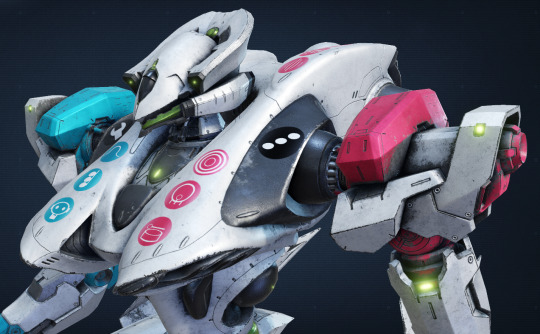

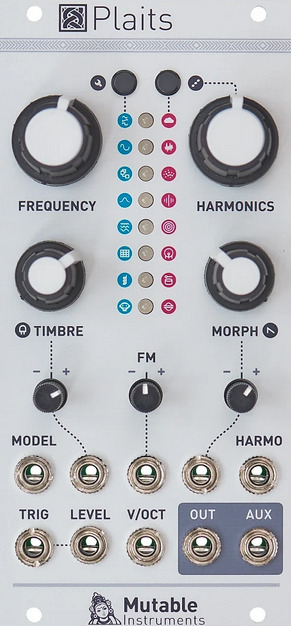


Most of the decals are on the Core and Head (someone didn't realize there was a decal limit until they hit it)
I'm hoping to load it up with a bunch of energy weapons and small explosives to emulate the various waveforms and percussive sounds you can get out of such a lightweight model. Ideally it'll be very nimble and whittle down enemies over time
Still need a cool name for it though... Suggestions?
181 notes
·
View notes
Text
Was the COVID-19 pandemic a premeditated operation involving aerosolized bioweapons deployed on unsuspecting populations?
Jon Fleetwood
Dec 24, 2024
Summary:
EcoHealth’s DEFUSE Proposal Exposed: In 2018, EcoHealth Alliance submitted a proposal to DARPA, codenamed DEFUSE, outlining plans to deploy aerosolized immune modulators, chimeric spike proteins, and/or self-spreading vaccines via drones, potentially over humans.
Aerosolized Vaccination on Humans: DEFUSE documents explicitly describe large-area aerosol delivery systems for “inoculation of animals/humans,” raising the question of whether these plans were executed on unsuspecting populations.
Drone Deployment and Pandemic Origin: The DEFUSE proposal and DARPA’s advanced drone programs suggest a chilling possibility: that drones may have played a role in the COVID-19 pandemic, challenging the mainstream lab-leak narrative.
DARPA’s Connection to Moderna: By 2012, DARPA was already working with Moderna on RNA-based spike protein vaccines. A 2016 Moderna patent contains a genetic sequence with a one-in-3-trillion match to the pandemic virus, igniting claims of bioengineering origins.
Suppression of DEFUSE Details: Whistleblower revelations show attempts by DARPA and intelligence agencies to classify and censor DEFUSE-related research. U.S. senators have demanded investigations into these actions.
Self-Spreading Vaccines and Gain-of-Function: DEFUSE documents reveal plans for self-disseminating vaccines and host-to-host therapeutic distribution, indicating the potential use of engineered viruses as vaccine delivery systems.
Unprecedented Drone Funding Surge: A 26% spike in military drone funding in 2019 aligns with DEFUSE’s timeline and its drone-based aerosol delivery technologies, hinting at pre-pandemic preparations.
International Drone Use During COVID-19: Governments worldwide deployed drones for “disinfecting,” but studies debunk the effectiveness of this practice, raising suspicion about the true purpose of these operations.
A Coordinated Bioengineering Agenda?: The alignment of DEFUSE, DARPA, and drone advancements reveals an unsettling intersection of gain-of-function research, bioweaponized delivery systems, and self-spreading vaccines.
Urgent Transparency Needed: The DEFUSE project raises alarming questions about the origins of COVID-19, the ethics of aerosolized bioengineering, and the U.S. government’s role in these developments. The public deserves truth and accountability, especially considering a potentially incoming bird flu pandemic.
17 notes
·
View notes
Link
In a quiet part of Northern California, where pine trees brush the sky and the hum of giant satellite dishes fills the air, something big is happening in science education. A new wave of college students is getting the chance to explore the universe — not through textbooks, but with real data from a world-class observatory. Thanks to a growing program called ARISE Lab, students and teachers from community colleges are diving deep into the science of space, radio signals, and the search for alien life. The SETI Institute, which focuses on the scientific search for extraterrestrial intelligence, has expanded this groundbreaking effort. With new support from a grant by the Amateur Radio and Digital Communication Foundation, the ARISE Lab (Access to Radio Astronomy for Inclusion in Science Education) is now reaching even more classrooms across the country. Making Space Science Hands-On The main idea behind ARISE is simple: when students get to do science themselves, they understand it better and stay interested longer. “Hands-on experiences are proven to improve student engagement and retention,” said Dr. Vishal Gajjar, a radio astronomer who leads the project at the SETI Institute. That’s why ARISE puts real scientific tools directly into students’ hands. The Allen Telescope Array at Hat Creek Radio Observatory. (CREDIT: Luigi Cruz) The program uses GNU Radio, a free and open-source software that lets users process radio signals. This gives students a way to study actual data from the SETI Institute’s Allen Telescope Array (ATA). The ATA is the first and only radio telescope in the world built just for detecting signs of advanced life beyond Earth — also called technosignatures. With these tools, students don’t just read about pulsars, spacecraft, or distant stars. They study them. They learn to sort signals, find patterns, and understand how astronomers listen to the sky. What the ARISE Curriculum Offers Dr. Gajjar and his team built the ARISE curriculum using something called experiential learning technique, or ELT. This method focuses on learning by doing. Students start with pre-lab reading, move through guided lab work, and then reflect on what they discover. Related Stories How podcasts are revolutionizing health education and behavior Groundbreaking discovery promotes verbal learning and fights memory loss New AI-based learning system provides personalized math instruction for students ARISE includes two types of content: modules and labs. Modules are more complete packages that come with slides, notes, reading materials, lab manuals, and instructor guides. They are designed to be added directly into a science class. Labs, on the other hand, are shorter, standalone activities that can be used by themselves or as part of a larger lesson. The labs cover a wide range of topics. Students might explore signal modulation — the way information travels through radio waves — or learn how data science applies to astronomy. Each lab has step-by-step instructions that make it easy for both students and teachers to follow. By linking lessons to the search for extraterrestrial life, ARISE grabs students’ attention. Research shows that this subject sparks more interest than almost any other topic in science. “With ARISE, we’re combining cost-effective tools like GNU Radio with one of the most captivating topics in science — the search for life beyond Earth — to spark curiosity and build skills across STEM disciplines,” Gajjar said. Vishal Gajjar, SETI Institute. (CREDIT: SETI Institute) Real Tools, Real Signals, Real Skills The ARISE team doesn’t just give students data and walk away. They create chances for them to experience what it’s like to work in space science. “Whether it’s detecting a signal from a Mars orbiter or analyzing pulsar data, students are gaining real experience with tools used in both professional astronomy and industries,” said Joel Earwicker, the project’s lead research assistant. “It’s about making science feel real, relevant, and achievable.” That real-world feeling is what sets ARISE apart. It connects students with data from the Allen Telescope Array, a set of 42 dish antennas located at the Hat Creek Radio Observatory. This array scans the sky daily, looking for faint radio waves that might come from intelligent life in space. Students learn how to filter out “noise” from human-made signals, track moving sources across the sky, and identify natural phenomena like pulsars — stars that blink like cosmic lighthouses. These skills mirror what professionals do in both astronomy and tech careers, building a direct path from the classroom to the workforce. Students examine live radio signals from deep space, learning to decode real astronomical data using modern tools and guided scientific methods. (CREDIT: SETI Institute) Growing the Program in 2025 After the program’s first pilot workshop at Hat Creek in 2024, the results spoke for themselves. Teachers loved it. Students stayed engaged. The SETI Institute decided to grow the effort. In 2025, ARISE will offer: 15 new labs on topics like astronomy, digital communications, and data analysis 2 hands-on workshops at Hat Creek to train instructors from community colleges On-site lab support at 10 schools to help teachers roll out the new content The team will also host an in-person workshop for six selected community college teachers from June 25 to June 27, 2025, at Hat Creek. These instructors will get travel and lodging covered. At the workshop, they will visit the telescope site, watch live observations, test out lab activities, and collaborate with other science educators. SETI efforts around the world. (CREDIT: SETI Institute) This expanded effort aims to bring advanced science training to places that often get left out of big research programs — local community colleges. These schools educate nearly half of all undergraduates in the U.S., and their students often come from backgrounds underrepresented in STEM fields. By targeting these schools, ARISE gives more people a chance to be part of space science. It also helps instructors bring fresh energy to their classes. Looking Up, Reaching Out When students see real data from space scrolling across their screens, something clicks. Science becomes more than just facts in a book. It becomes a search — one they can be part of. With ARISE, the SETI Institute is changing how students learn science. Instead of memorizing equations, they explore the universe. Instead of just hoping to understand radio signals, they decode them. By giving students the tools, data, and support to study space firsthand, ARISE opens doors — to science, to careers, and maybe even to the stars. Research findings are available online on the SETI Institute website. Note: The article above provided above by The Brighter Side of News. Like these kind of feel good stories? Get The Brighter Side of News’ newsletter. The post New SETI program helps students detect signs of advanced life beyond Earth appeared first on The Brighter Side of News.
7 notes
·
View notes
Text

What made the D-21 unique was its mission profile: once launched from the mothership, the D-21 would penetrate enemy airspace along a pre-set flight path, then return to a secure area to eject its electronics module containing the camera, photographs, and navigational systems. Once the mission was complete, the drone was programmed to self-destruct. 4/5
@RealAirPower1 via X
15 notes
·
View notes
Text

Upgrade your Chrysler pcm with Clifford Auto Parts. We offer high-quality, ready-to-install Chrysler pcm modules. It ensures immediate compatibility and optimal performance. Whether you need a Chrysler ecu programming or repair, we provide reliable solutions to keep your Chrysler running smoothly.
Visit us to know more: https://cliffordautoparts.com/product-category/chrysler/
#electronic control module#engine control module replacement#engine control module price#ecu repair service#automotive ecu repair#ecu for sale#ecu for car#pcm module#pcm rebuilders#pre programmed pcm#pcm powertrain control module
0 notes
Note
That’s very interesting! How would Dream and Nightmare being brothers be adapted to that kind of AU?
Good Question! I can see a few options.
But first some notes for context:
In a bid to appeal to human social conventions (and of course, to encourage the purchase of even more bots) the bots are often advertised as having pre-programed relationships with each other. Which, you as the costumer, are meant to discover as you buy more or socialize with neighbors and their bots. This is why it’s common for some individuals to be sold in sets and why such a large diversity in personality is allowed.
Option 1) bots fresh out of the factory come programed with a list of pre-determined dynamics to the other bots of their specific set (experience expands that list). Sans and Papyrus, for example, obviously identify themselves as brothers. Though this gets a little complicated with Toriel and Asgore. (Divorce is not marketable but I think it would be hilarious if this was a common thing that happens with your Tori-bot anyway. Especially if no one in the company can figure out how to prevent it. At least with Classic Toriel. Autonomy, free will and things like governor modules are something to think about in different post)
Anyway.
Dream and Nightmare are likewise sold together as brothers in a set. Unlike Sans and Pap, you couldn’t buy Dream without his brother. I Imagine they were a very expensive edition from an incredibly limited production (like for New Years or Christmas) or a customized set ordered by some rich playboy billionaire who wanted a one of a kind product to flaunt his wealth with.
Or
Option 2) Dream and Nightmare were developed and trained within the same facility, prototypes for a new line that was never completed or made available to the public. Something something nature vs nurture and the human tendency to see ourselves everywhere, and to imprint on anything with a recognizable face, led to one of their human handlers teaching them the meaning of family and sibling-hood (when they weren’t supposed to) before something went horribly, horribly wrong with Nightmare.
93 notes
·
View notes
Text
Cosmos Above Custom Order: Lotus

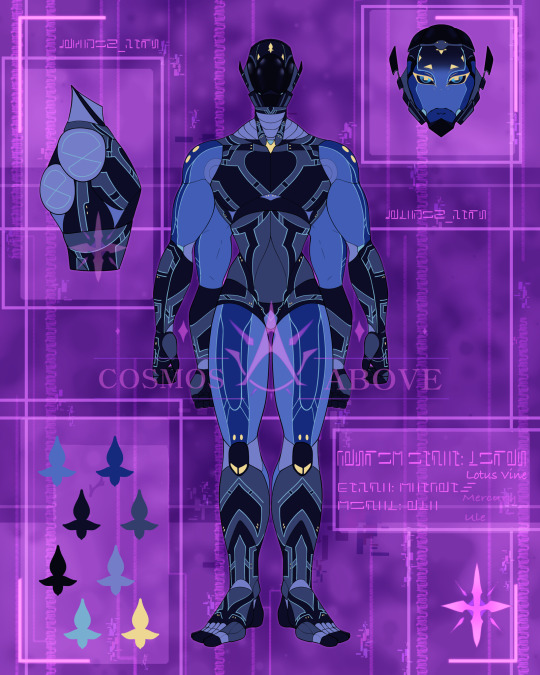
Ever the willing participant in my schemes, @quilandscroll had the opportunity to proof check the CA Robotics commission form and the result was this lovely duo who now go by Vassan (left) and Vistor (right).
Vistor is a Mercury grade Ebor unit, meaning he's a custom built domestic protection unit, hence the arms. Because he's "made to order", Vistor has unique features mixed and matched that don't strictly adhere to the market standard for an Ebor, however one feature he cannot avoid is the hard requirement of an Ebor having a Lock.
That brings us to Vassan, who is a great example of some of the odd things you can find among the robots of Azil. It's not common for a Task Manager (Vistor) to be bound to a Stellis P-C (Vassan) but it can be done. In their case, because Ebor units flip between domestic and security modes in response to situations or conditions, they need a "control" unit which is meant to assess and validate their request to take action and limit them if they go berserk. Vassan is Vistor's trigger switch and built into Vistor's AI as a necessary part of it; if something happens to Vassan, it will devastate Vistor's AI (and vice versa).


Hilariously, their attitudes are almost completely opposite what you would expect from their models. While "keynotes" exist as preset personality traits that are often fitted and matched to work together, they are merely a basis upon which the self-learning AI grows and this can have some odd or unexpected effects depending on what happens while they grow and whether they achieve Awareness (Awakening).
Vistor is a fairly calm, mindful and diplomatic bot with a fairly even split of Diurnal and Nocturnal keynotes. Some of them are "contradictory", as in they can cause conflict in developing AI without careful programming, thus he was made Mercury grade to allow for that. How these traits have since manifested has allowed him to become the calm, well-meaning bot he is today.
Diurnal:
Small talk
Supportive
Responsible
Soft-hearted
Nocturnal:
Good listener
Grounded
Thought-focused
Well-meaning
Honest
Vassan on the other hand... Well... due to the limitations of Pocket Companion AI, he doesn't have the same capacity for growth and complexity Vistor does. Often, P-Cs have simple behavior modules pre-installed that can be reinforced by their owner over time but a majority of their self-expression imitates that of their owner due to learning by imitation and observation. Vassan tends to be... a lot of personality and would absolutely bite if he had a mouth that worked. Thankfully his preference for violence and mayhem is limited due to him only being about 8 inches tall and Vistor is well-regulated enough to not give in to every request to punch someone that Vassan sends him.
Because of who they were made for and things Vistor would rather avoid discussing prior to his defection to rogue/independent status, he dislikes using his security features and has even go so far as to acquire plastimold (silicon) body covering to hide his muscular banding and limit access to the integration ports on his upper arms. The visor was a fun detail that becomes relevant once you understand the perception of helmets and visors as short hand for "protection" on Azil due to their association with Madin Search & Rescue units.
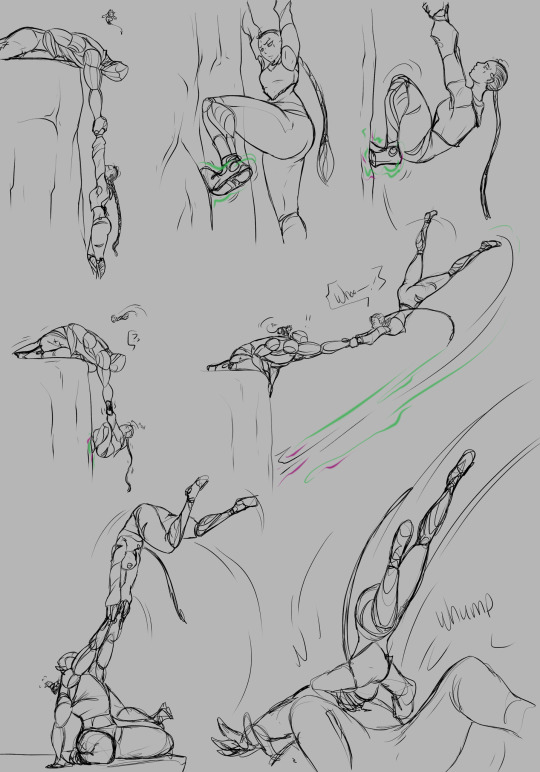

While searching for a place to be themselves, the pair ended up with a mentorship at the Runner Guild alongside Lotus's currently-unnamed Runner OC. It's hard work learning the ins and outs of navigating the wilds, but having someone that sees you as just another person regardless of your past and purpose makes it just a little bit easier <3
#azil#free runner#robots#world building#task managers#stellis#ebor unit#vistor&vassan#free runner oc#commission#custom
6 notes
·
View notes
Text
Integrating Skill Assessments into Your Existing HR Systems

Introduction
As organizations strive to build a skilled and efficient workforce, integrating skill assessments into existing HR systems has become a crucial strategy. By embedding skill evaluations within HR workflows, companies can enhance hiring accuracy, streamline employee development, and make data-driven workforce decisions. This blog explores the benefits, challenges, and best practices of integrating skill assessments into HR systems, with insights on how platforms like Gappeo can facilitate the process.
Why Integrate Skill Assessments into HR Systems?
Integrating skill assessments within HR platforms offers numerous advantages, including:
Improved Hiring Accuracy: Objective skill evaluations help recruiters identify the most suitable candidates, reducing reliance on resumes alone.
Efficient Onboarding: Pre-assessed skills enable HR teams to tailor onboarding programs, ensuring new hires receive targeted training.
Employee Development & Training: Ongoing skill assessments allow HR teams to track employee growth and implement personalized training programs.
Workforce Planning: Insights from assessments help HR leaders identify skill gaps and plan for future workforce needs.
Key Considerations for Integration
Before incorporating skill assessments into your HR system, consider the following:
Compatibility: Ensure the assessment platform integrates seamlessly with your existing HR software (e.g., ATS, LMS, or HRIS).
Customization: Choose a system that allows tailored assessments aligned with job roles and industry needs.
Scalability: The platform should support growing workforce demands and adapt to evolving skill requirements.
User Experience: Both recruiters and candidates should find the system easy to navigate and engage with.
How Gappeo Simplifies Skill Assessment Integration
Gappeo, a leading talent and skill assessment platform, offers seamless integration with various HR systems. Key features include:
Pre-Built API Integrations: Easily connect with popular HR platforms.
Customizable Assessment Modules: Design skill tests specific to job roles.
Audio and Video Assessments: Enhance evaluation accuracy by analyzing verbal and non-verbal cues.
Comprehensive Reporting: Generate insights to support hiring and workforce development decisions.
Steps to Successfully Integrate Skill Assessments
Evaluate Your HR System: Assess your current HR software capabilities and identify integration points.
Select the Right Assessment Platform: Choose a solution like Gappeo that aligns with your HR objectives.
Customize Assessments: Develop skill tests that reflect the competencies required for different roles.
Pilot Test the Integration: Run a small-scale implementation to ensure seamless functionality.
Train HR Teams: Educate HR personnel on using the integrated system effectively.
Monitor and Optimize: Continuously track performance metrics and refine assessment processes.
Conclusion
Integrating skill assessments into HR systems is a game-changer for talent management, enabling data-backed hiring, employee development, and strategic workforce planning. With solutions like Gappeo, organizations can streamline skill evaluations while ensuring a seamless experience for both HR professionals and candidates.
Ready to enhance your HR processes? Discover how Gappeo can help you integrate skill assessments effortlessly!
#assessment#hiring#recruitment#saas development company#saas platform#hr#hrsystems#hrprocesses#evaluation
3 notes
·
View notes
Text
The pop-sci takeaway from the Apollo program is always "if we'd only kept building more Saturn Vs we'd be on Mars by now!", which is of course very tempting to believe - it's an iconic rocket, undeniably very cool. Unfortunately the truth is, imo, more along the lines of Saturn V being a historic mistake from the start; the post-Apollo stagnation was assured more or less the moment we agreed on taking the fastest route - a big booster lofting the whole mission at once.
So it's like, launch cost is almost entirely dominated by the fixed cost of infrastructure - this is why Shuttle became such a white elephant by the way, the original hopeful cost figures were predicated on a twenty-to-fifty a year flight rate. We achieved, at best, nine (and then more or less immediately after the Challenger happened, but this is a whole other tangent). Saturn V had two real payloads - the Apollo missions, and Skylab. In the absence of sustained 1969 mission cadence and all the enormous funding commitments that entailed, the huge fixed infrastructure of Saturn V would have rusted on the Cape Canaveral coast most of the year waiting for a single mission, even if they hadn't closed the production lines before the first piloted Apollo mission even launched.
How could this have been different? Plausibly we could have gone with an EOR (Earth Orbit Rendezvous) or even split LOR (Lunar Orbit Rendezvous) plan, much like the original plans proposed by Von Braun at the pre-NASA Army Balistic Missile Agency - flotillas of smaller Saturn 1B (~20t to LEO) or Saturn C3 (~50t to LEO) launches carrying the crew module, the Trans-Lunar-Injection stage, the lunar lander, and propellant for all of the above to staging points in Low Earth Orbit, where they'd be put together like god's own lego set and sent on their way. This, notably, would have allowed two things - one is amortization of the launch infrastructure over more flights, which also allows for learning-curve cost reduction as tooling gets better at handling successive launchers. The other is amortization of the enormous fixed cost of a space launch complex and it's concomitant "standing army" of technicians and their support staff over a great many launches. Notably, unlike the massively oversize Saturn V, those launchers would also have had the ability to cost-effectively launch other payloads during 'off season' - commsats, military birds, weather satellites, space probes, whatever - more cost effectively, driving down the effective cost of a single launch yet further.
This would all be water under the bridge, of course, if it hadn't convinced everyone since that we simply can't do missions to the Moon without a hundred tons of throw weight to LEO - after all, that's what the sole example looked like! One study carried out by the 2000s Augustine Commission (a government advisory group founded in the wake of the Ares Program's failure to produce a big new rocket), found that even then we could have achieved lunar missions with only slightly upgraded versions of the existing EELV (Evolved Expendable Launch Vehicle) fleet and some orbital aggregation. This was unfortunately discarded in favor of yet another big rocket though. I guess that's just the way things go, but it is unfortunate imo!
23 notes
·
View notes
Text
Summary:
EcoHealth’s DEFUSE Proposal Exposed: In 2018, EcoHealth Alliance submitted a proposal to DARPA, codenamed DEFUSE, outlining plans to deploy aerosolized immune modulators, chimeric spike proteins, and/or self-spreading vaccines via drones, potentially over humans.
Aerosolized Vaccination on Humans: DEFUSE documents explicitly describe large-area aerosol delivery systems for “inoculation of animals/humans,” raising the question of whether these plans were executed on unsuspecting populations.
Drone Deployment and Pandemic Origin: The DEFUSE proposal and DARPA’s advanced drone programs suggest a chilling possibility: that drones may have played a role in the COVID-19 pandemic, challenging the mainstream lab-leak narrative.
DARPA’s Connection to Moderna: By 2012, DARPA was already working with Moderna on RNA-based spike protein vaccines. A 2016 Moderna patent contains a genetic sequence with a one-in-3-trillion match to the pandemic virus, igniting claims of bioengineering origins.
Suppression of DEFUSE Details: Whistleblower revelations show attempts by DARPA and intelligence agencies to classify and censor DEFUSE-related research. U.S. senators have demanded investigations into these actions.
Self-Spreading Vaccines and Gain-of-Function: DEFUSE documents reveal plans for self-disseminating vaccines and host-to-host therapeutic distribution, indicating the potential use of engineered viruses as vaccine delivery systems.
Unprecedented Drone Funding Surge: A 26% spike in military drone funding in 2019 aligns with DEFUSE’s timeline and its drone-based aerosol delivery technologies, hinting at pre-pandemic preparations.
International Drone Use During COVID-19: Governments worldwide deployed drones for “disinfecting,” but studies debunk the effectiveness of this practice, raising suspicion about the true purpose of these operations.
A Coordinated Bioengineering Agenda?: The alignment of DEFUSE, DARPA, and drone advancements reveals an unsettling intersection of gain-of-function research, bioweaponized delivery systems, and self-spreading vaccines.
Urgent Transparency Needed: The DEFUSE project raises alarming questions about the origins of COVID-19, the ethics of aerosolized bioengineering, and the U.S. government’s role in these developments. The public deserves truth and accountability, especially considering a potentially incoming bird flu pandemic.
11 notes
·
View notes
Text
06/07/2023 || Day 46
I woke up this morning completely exhausted and my brain wasn't working. It wasn't until 4pm when I decided to just go on a walk for an hour that I felt ok. Dunno what's up with that...
Remember how I said yesterday that I'd get started on React? Well, I started to watch a video and the person went over the pre-requisites for learning React (i.e. what Javascript concepts you need to know), and I basically had to learn a lot of concepts related to ES6 such as arrow functions, modules, destructuring objects, spread operators, and other stuff, and I realized I knew none of those. So...I watched another video that went over all that, and while the video itself was only an hour long, it took me about 2-3 hours to get through it because I was constantly pausing the video and writing notes.
Anyways, this wasn't the first video by this guy that I've watched and I really like watching his videos for longer introductions to topics, so here's a link:
62 notes
·
View notes